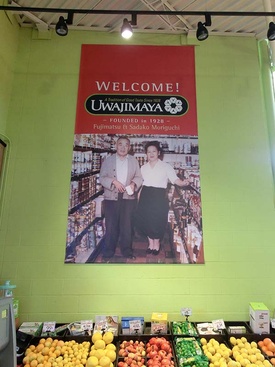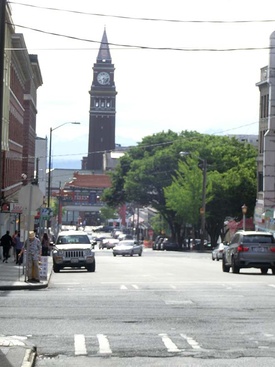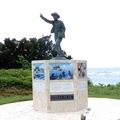Part 1>>
The customers are a balance of Japanese, Asian and non-Asian.
On the other hand, the company's flexibility in product lineup, which started out targeting Japanese people and Japanese descendants, but gradually adapted to the growing popularity of Japanese food, helped to increase sales.
Uwajimaya's customer base is roughly one-third Japanese or of Japanese descent, one-third non-Japanese Asian, and one-third white or other non-Asian. This balance seems to work well.
"From now on, we would like to open stores like the one we have in Bellevue. We want to sell high-quality products," said the CEO, who is enthusiastic about opening new stores, and it appears that they will be pursuing a strategy to differentiate their stores from others.
Moriguchi owns a condominium near the current Uwajimaya, which has "Fujisada" written in large kanji on the building, and near the entrance to the Bellevue store is a large blown-up picture of a pine tree and Sadako from the old Uwajimaya days, both in tribute to his parents.
It started as a small shop selling fish cakes and survived the war
The founder, Fujimatsu Moriguchi, was born in Yawatahama Town (now Yawatahama City) in the western part of Ehime Prefecture and came to the United States in 1923. In 1928, he opened a small store selling Japanese groceries in Tacoma, Washington, a port city about 50 kilometers south of Seattle.

A poster displayed inside the Bellevue store (Moriguchi and his wife, showing the store at the time)
The store sold homemade foods such as satsumaage and tofu to Japanese and Japanese-Americans who had immigrated from Japan.
The store's name was written in kanji as "Uwajimaya," a reference to the area near Uwajima in Ehime Prefecture where Fujimatsu worked while he was in Japan.
"I remember pumping tofu out of the cold water," Kenzo says, recalling watching his father work from his childhood.
Fujimatsu's wife Sadako was from the Tsutakawa family, a long-established grocery store in Seattle, and was born in America but educated in Japan. After they got married, she ran a store with Fujimatsu in Tacoma.
However, when the war began, the Moriguchi family, like other Japanese Americans, were forced into internment camps and were sent to the Tule Lake Internment Camp in California, where Tomio was 6 years old. When the war ended, the Moriguchi family left the camp and moved to Seattle, where Fujimatsu and Sadako soon reopened Uwajimaya.
Popular in the community and Japanese community
Customers included local Japanese Americans, and after a few years, "war brides" who had married American men began to arrive. Japanese students also began to study at the local University of Washington.
For these people, Uwajimaya, which sells Japanese food in foreign countries, was in demand.
"Customers would buy things like rice, takuan (pickled radish), and salted salmon, but for those who had limited money, Sadako would treat them to rice with ochazuke and treat them well. Some of the people who came to the store back then now bring their great-grandchildren."
As Tomio recalls, stories of how his mother Sadako would watch over the customers' situations and take care of them in ways that went beyond the relationship between store and customer are still heard among older Japanese people today.
Cargo ships from Japan also began to arrive in Seattle's port, and many of the Japanese crew members came to the city and became welcome customers.
After the war, Kenzou, who had been discharged from the military, began helping out at the store, and Tomio, who had graduated from the University of Washington and started working as an engineer at Boeing, also quit after a year and a half to help out at the store.
After the war, Japanese Americans living along the West Coast left the internment camps and were reinstated as Americans, but in reality there was still invisible discrimination when it came to employment.
"My mother was always working hard, so I naturally wanted to help out with her work. I'd been helping out with the business since I was little, and I didn't have a particularly high position at the company," Tomio says with a laugh.
The 1962 Seattle World's Fair marked a breakthrough
Around 1950, people from Japan started coming to sell various products, and as they stocked these products, business grew.
That year, the World's Fair was held in Seattle, and Uwajimaya had a store there for six months. Not only did it attract customers from the fair, but it also attracted locals, who became new customers, and Uwajimaya's name recognition increased.
However, at the end of that year, the owner Fujimatsu passed away and Tomio took over, and the store was incorporated in 1965. He says:
"My father (Fujimatsu) used to say that Japanese Americans would start eating more American food. But unexpectedly, Japanese food ended up becoming popular. At first, we didn't think electric rice cookers would sell, but they quickly started to sell well. People other than Japanese started buying them too. More and more people are eating tofu for health reasons. Chinese people have always come here, but after the Korean War, war brides from Korea also came and became customers."
It has become clear that Japanese food has great potential, and that it is not just Japanese people who are embracing it.
In this way, the company grew with a focus on Japanese food ingredients, and in 1970, it opened a new store two blocks away on a 20,000-foot site, making it the largest Japanese food supermarket in the Northwestern United States at that time. Eight years later, it purchased an additional site of an equal size.
Then, in November 2000, Uwajimaya Village was opened nearby. With a supermarket at its core, it also has a food court and a section selling daily necessities and gifts, and the space above the stores is used as apartments.
The facade of Uwajimaya Village features a calming beige and pink exterior with a deep blue tiled roof. Entering the store, there are indeed Japanese foods lined up that you won't find in regular supermarkets, but the customers visiting the store appear to be of various races.
It's a unique restaurant, but it also reflects one aspect of American food culture. Japanese food, especially sushi, is now available all over the United States. However, at the same time, the number of Japanese restaurants owned by foreigners is also on the rise.
In this context, Uwajimaya, which is developing while carrying the history of Japanese people, is a good example of the internationalization of Japan and Japanese people that goes beyond the framework of a single supermarket.
*This article is reprinted from JB Press (Japan Business Press) (published on July 30, 2012).
© 2012 Ryusuke Kawai, JB Press











